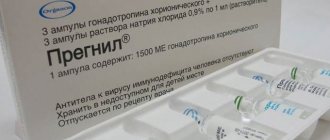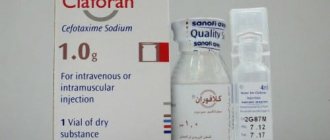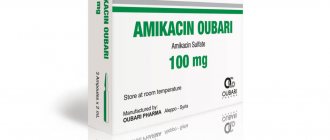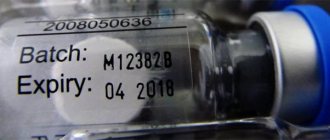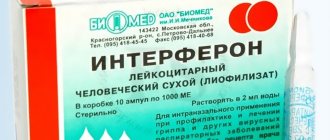Composition, release form, price of the drug
The medicine can be found on pharmacy shelves in the form of a lyophilized powder used for parenteral administration. It is in a transparent glass bottle and has a yellow-green color. When you shake the bottle, you will notice that the powder is compressed and looks like a large tablet.
Each bottle comes with a clear glass ampoule containing 2 ml of solvent. In an individual cardboard box you can find instructions for using the product, 3 ampoules with solvent and 3 bottles with lyophilized powder.
The product contains the active component tenoxicam, which has the main therapeutic effect.
Each bottle contains 20 mg of active ingredient and excipients:
- Ascorbic acid.
- Hydrochloric acid.
- Sodium edetate.
- Sodium hydroxide.
- Mannitol.
- Trometamol.
Auxiliary ingredients do not have a therapeutic effect. The drug is dispensed from pharmacies only with a doctor’s prescription, which eliminates the risk of complications as a result of self-medication. The cost of the medication in different pharmacies and regions may vary, but the average price is approximately 600-85 rubles.
Cases when the drug is contraindicated
The first and main contraindication to the use of Artoxan is intolerance to at least one of the substances of the drug.
In addition, Artoxan injections are contraindicated if the patient has:
- ulcerative lesions of the gastrointestinal tract in the acute stage;
- hemorrhages in the gastrointestinal tract;
- chronic form of renal failure;
- intestinal pathologies caused by inflammatory processes;
- progressive kidney diseases;
- blood diseases.
The drug should be used with extreme caution when:
- ulcerative colitis without exacerbation;
- chronic gastrointestinal ulcers (not during exacerbation);
- hepatic porphyria;
- liver diseases of various etiologies;
- chronic heart failure;
- diabetes mellitus;
- bronchial asthma (regardless of the form);
- autoimmune diseases.
Taking all this into account, the drug can only be taken as prescribed by a doctor in compliance with all recommendations and dosages.
Operating principle and effectiveness
Artoxan - injections, patient reviews of which can be positive and negative. The active substance of the drug belongs to the group of non-steroidal anti-inflammatory ingredients, and therefore has a pronounced effect on the patient’s body.
The principle of action of the drug is based on the ability of tenoxicam to influence components that provoke the inflammatory process. As a result of blocking their production, the condition of the tissues improves and the spread of the inflammatory process is prevented.
It is worth noting that tenoxicam specifically blocks the production of cyclooxygenase type 1, which is considered the most effective in combating the inflammatory process.
Additionally, the medication has analgesic properties, which significantly alleviates the condition of patients during exacerbation of a particular disease. After the acute pain is relieved, the affected tissues are gradually restored, and the patient’s sleep is normalized, which in most cases is disturbed during the period of relapse.
The antipyretic properties of the drug make it possible not to use additional drugs for the purpose of local or general reduction in body temperature. In addition, eliminating the heat in the affected area leads to significant relief of the patient's condition.
It is noted that when using the drug, the progression of the pathological process slows down, which is also considered an advantage. In combination with other medications, treatment is accelerated because a complex effect is achieved.
Additionally, the active ingredient of the product affects the patient’s cartilage tissue, reducing the activity of enzymes in it that provoke degenerative changes in joint joints.
When using the medication, the therapeutic effect appears after approximately 5-7 days. During this period, a certain amount of the active component accumulates in the affected tissues, which makes it possible to block cyclooxygenase and alleviate the course of the pathology.
With parenteral administration of the drug, a fairly rapid distribution of the active substance throughout the systemic bloodstream occurs. As a result, tenoxicam is concentrated in the affected area and has a therapeutic effect. The ingredient is able to penetrate the placental barrier and enters breast milk.
The largest amount of the substance is concentrated in the synovial fluid of the joint, which explains its high effectiveness in the treatment of joint pathologies of varying severity. In addition, the product accumulates in cartilage tissue, which enhances the effect of the medication.
After administration, the maximum concentration of the ingredient in the blood is achieved after 20 minutes. the drug binds well to blood proteins, which explains its high bioavailability and fairly rapid onset of therapeutic effect. The advantage of the drug is considered to be a rather long elimination period, which can reach 3-4 days.
That is why the medicine acts for a long time, which eliminates the need to re-introduce the drug.
The active ingredient is processed in the liver, where it breaks down into inactive metabolites. The main amount of metabolites is excreted by the kidneys. Only a small part is evacuated with feces.
In patients who suffer from pathologies of the liver, stomach or intestines, as well as kidneys, there is a slowdown in cleansing the body of the breakdown products of the drug. However, when the disease is not advanced, the effectiveness of treatment does not decrease.
It is worth noting that in elderly patients the rate of absorption and evacuation of components is somewhat reduced, which slightly weakens the effectiveness of treatment. The effectiveness of therapy with the drug has been proven by the experience of many patients of different ages. The drug helps improve the condition of patients with chronic and acute conditions, and its correct use helps to avoid complications.
Pharmacological properties
Artoxan belongs to the group of NSAIDs (non-steroidal anti-inflammatory drugs). By mechanism, it is a non-selective (non-selective) inhibitor of cyclooxygenase (COX). The drug inhibits (inhibits the action) cyclooxygenase of the first and second types. COX-1 is physiological, that is, it is constantly present in the body (in the gastric mucosa). COX-2 begins to be actively synthesized by the body at the site of inflammation, it is pathological (inflammatory).
In the body, during the inflammatory process, damage and destruction of cells occurs at the site of inflammation. A metabolite emerges from them - arachidonic acid. Under the influence of the enzyme cyclooxygenase, the formation of thromboxane A2 begins (constricts blood vessels), prostaglandins (dilates blood vessels, increasing the release of inflammatory fluid into the tissue).
Due to the mechanism of action, 3 main pharmacological effects of the drug Artoxan are ensured:
- Painkiller (analgesic). This is explained by the fact that when the enzyme cyclooxygenase is inhibited, the activity of the inflammatory COX-2 decreases. As a result, the production of prostaglandins, which causes local swelling (compressing tissue), decreases and the intensity of pain decreases. In addition, NSAIDs inhibit the transmission of pain impulses through the nervous system (to a lesser extent).
- Antipyretic. Occurs at 2 levels: thermoregulation and at the site of inflammation. In the brain, the activity of neurons that are responsible for increasing body temperature during inflammation decreases. Under the influence of type 2 cyclooxygenase, less thromboxane A2 is synthesized, so the vessels dilate rather than narrow. In this case, the transfer of heat from the human body to the environment begins to exceed the formation of heat in the human body. Therefore the temperature decreases.
- Anti-inflammatory. When the action of the main enzyme necessary for the inflammatory process (COX-2) is inhibited, the activity of inflammation subsides.
Artoxan has 100% bioavailability. After administration, the concentration of the drug in the blood increases sharply, reaching its maximum after 120 minutes. It circulates in the body for a long time. The half-life (decrease in the concentration of tenoxicam in the blood by 2 times) occurs at the end of 3 days after administration. Artoxan easily passes through the blood-brain barrier (brain) and the placenta. The drug penetrates well into the intra-articular fluid.
Artoxan undergoes metabolic processes with the help of the enzymatic system of the liver. 70% leaves the body with urine through the kidneys, 30% with feces through the intestines.
How long does it take for the drug to start working?
Artoxan - injections, patient reviews of which are often positive, which is associated with the rapid onset of a therapeutic effect. Elimination of pain and a decrease in body temperature in the affected area is observed within 15-20 minutes after administration.
Despite this, the anti-inflammatory effect of the drug appears only on days 5-7 of therapy, which is associated with the gradual accumulation of the active ingredients in the tissues. Due to the rapid elimination of the most pronounced manifestations of the disease, patients prefer this particular medicine.
Reviews about the drug Artoxan
Patients note that after a three-day course of treatment they felt much better; the injections, although painful, act quite quickly. After about 10-15 minutes, the pain in the joints went away, and it became easier to move. For some patients, the drug helped within half an hour; there were no adverse reactions from the body.
Patient review
Patients say that Artoxan was prescribed to them along with other drugs; on average, injections were given for 3 days. Sometimes there were incomprehensible symptoms, dry mouth, rapid heartbeat, and changes in blood pressure. In general, the drug is well tolerated.
Reviews on the Internet show that the price of injections is quite high. But at the same time, patients recommend this remedy, since it is really effective and helps very quickly, in comparison with cheaper analogues.
Indications for use
The drug is used for various pathological conditions, the course of which is accompanied by severe pain, local and general increase in body temperature, as well as an inflammatory process in the tissues.
Main indications for use of the drug:
- Arthritis of rheumatoid or other origin. In this case, the remedy is used when large articular joints are affected or when several small joints are involved in the process at once. For polyarthritis, the medicine is as effective as for damage to one compound.
- Osteoarthritis at different stages of development, which is accompanied by significant changes in bone tissue and disruption of the functioning of the spinal cord, pinching and other disorders.
- Coxarthrosis at different stages of development. As a rule, the medicine is prescribed at the initial and progressive stages, when synovial fluid remains in the joint capsule, where the active ingredient of the drug can concentrate.
- Gonarthrosis of traumatic or degenerative-dystrophic origin. In the first case, the drug is used in short courses only to eliminate pain, in the second it is indicated during periods of relapse of the disease.
- Osteochondrosis with severe pain associated with pinched nerve endings.
- Bursitis at different stages. In this case, inflammation of the synovial bursa may be accompanied by the development of a purulent process, but the effectiveness of the medication does not decrease.
- Tenosynovitis, which in most cases occurs due to injury, sometimes becomes the result of degenerative processes.
- Pain syndrome due to injuries of soft tissues or limbs, as well as in the case of serious fractures of the limbs and spinal column.
- Severe burns affecting a large area of skin.
- Muscle pain due to tissue damage or as a result of neurological pathologies affecting the muscles.
- Neuralgia and neuritis of various origins.
- Radicular syndrome that develops against the background of chronic radiculitis and worsens during relapse.
- Menstrual pain in women of different ages.
- Headache or toothache that significantly worsens the patient's condition.
- Migraine of moderate intensity, when there is a weakening of sensations when taking conventional analgesics.
- Joint and muscle pain, often occurring in elderly patients as a result of changing weather conditions.
It is worth noting that the remedy does not help cure the underlying disease. It only eliminates acute manifestations and slightly slows down the progression, which cannot be a substitute for complex treatment. The use of injections is considered a temporary measure to alleviate the condition.
Impact on the body
The use of the drug helps relieve the inflammatory process, normalize body temperature, eliminating hyperthermia. The product also relieves pain, prevents platelets from sticking together, prevents the accumulation of leukocytes at the site of inflammation, and reduces the activity of proteoglycanase and collegenase enzymes in cartilage tissues.
Absorption of the active substance of the drug occurs quickly and completely. Its maximum concentration in the blood is observed 2 hours after administration to the body. A distinctive feature is its prolonged action (up to 72 hours).
The metabolic process occurs in the liver. Excretion: 1/3 – through the intestines with bile, the remaining 2/3 – through the kidneys.
Contraindications and side effects
Artoxan is not prescribed if you are intolerant of its components or have a tendency to allergic manifestations.
Reviews from many patients confirm that the reaction can be very pronounced. Injections are contraindicated in the following cases:
- Pregnancy and lactation period. At this time, the drug can provoke complications not only in the mother, but also in the child.
- Diagnosis of Crohn's disease and ulcerative colitis in the acute stage.
- Peptic ulcer of the stomach and duodenum in acute form. However, parenteral administration does not help to avoid negative effects on the mucous membranes of the stomach.
- Internal bleeding associated with damage to the digestive tract. This takes into account not only the presence of pathological symptoms at the time the medication is prescribed, but also the presence of a similar diagnosis in the anamnesis.
- A severe form of renal failure, which is accompanied by severe disruption of the functioning of the organ.
- Liver failure in acute and chronic form, hepatitis of viral origin, cirrhosis of the liver. All these diseases lead to difficulty in absorbing the medication, which reduces its effectiveness.
- Decompensated form of heart failure, severe coronary heart disease.
- The recovery period after myocardial infarction, as well as surgery involving coronary artery bypass grafting.
- Blood pathologies associated with impaired blood clotting. This contraindication is due to the fact that the active substance of the drug affects the process of platelet adhesion. Due to this, bleeding may develop in patients who are prone to such disorders.
- Intolerance to acetylsalicylic acid and medications that contain it. Even if there is a history of such a restriction, you should treat the medication with caution.
- Gastritis and gastroduodenitis in acute form, resulting from the activation of the bacterium Helicobacter pylori.
- Severe form of bronchial asthma in the relapse stage.
- Severe autoimmune pathologies with the development of complications from internal organs.
The medication is used with caution in the treatment of patients who have had bad habits for many years. For patients over 65 years of age, the drug is prescribed less often and only if there are strict indications. The medication is contraindicated for children under 18 years of age, since its ingredients can negatively affect the condition of the body.
You should not use the medication without prior examination and consultation with a doctor. Self-treatment can lead to serious complications.
Artoxan - injections, patient reviews of which help evaluate the effect of the medication before starting use. It is important to remember that negative reactions can occur even if the instructions for use are followed.
| Organs and systems | Most common side effects |
| Nervous system | Headache and dizziness during treatment are considered a common negative reaction. In addition, patients are worried about insomnia, depression, and sudden changes in mood in one direction or another. Symptoms usually disappear after stopping the course of therapy. |
| Digestive tract | Pain in the stomach, nausea and vomiting occur in patients suffering from any diseases of the digestive tract. In addition, it is possible to develop intestinal colic, severe pain during bowel movements and stool disorder, manifested in the form of constipation or diarrhea. |
| Vessels and heart | Pain in the heart area appears in most cases in patients over 50 years of age. In addition, heart rhythm disturbances, the development of tachycardia and worsening cardiac pathologies are possible. On the part of the blood system, a significant decrease in the number of platelets is possible, causing bleeding. |
| Musculoskeletal system | In the first few days after starting treatment, severe pain in the joints and muscles may occur. As a rule, manifestations disappear after 3-4 days. If they worsen, you should refuse treatment. |
| Skin | An allergy to the medication manifests itself in the form of a rash on the body, itching and peeling. |
In case of an overdose, all adverse reactions are aggravated, and the patient's condition suddenly worsens. In addition, the development of fainting or an attack of convulsions is possible if the patient suffers from any neurological diseases.
The appearance of complications is considered a reason to refuse to use the drug. If symptoms of overdose are observed, you should immediately visit a doctor. In a hospital setting, a specialist will prescribe a gastric lavage procedure and medications to eliminate symptoms.
special instructions
During treatment, it is necessary to monitor the picture of peripheral blood and the functional state of the liver and kidneys, the prothrombin index (while taking indirect anticoagulants), and the concentration of glucose in the blood (while using hypoglycemic agents).
If it is necessary to determine 17-ketosteroids, the drug should be discontinued 48 hours before the study.
Bleeding time may increase, which should be taken into account during surgical interventions.
It is necessary to consider the possibility of sodium and water retention in the body when prescribed with diuretics in patients with arterial hypertension and heart failure.
Patients with uncontrolled arterial hypertension, chronic heart failure, peripheral arterial disease, confirmed coronary artery disease and/or cerebrovascular disease should take the drug under medical supervision.
A history of kidney disease can lead to the development of interstitial nephritis, papillary necrosis and nephrotic syndrome. Undesirable effects can be minimized by using the minimum effective dose of the drug in the shortest possible course.
Due to the negative effect on fertility, the drug is not recommended for women wishing to become pregnant. In patients with infertility (including those undergoing examination), it is recommended to discontinue the drug.
Patients with systemic lupus erythematosus (SLE) and mixed connective tissue disease are at increased risk of developing aseptic meningitis.
During the treatment period, the speed of mental and motor reactions may decrease, so it is necessary to refrain from driving vehicles and engaging in other potentially hazardous activities that require increased concentration and speed of psychomotor reactions.
Instructions for use
Artoxan - injections, patient reviews of which prove effectiveness if used correctly. The drug is administered intramuscularly deeply at a dosage of 20 mg per day, that is, no more than 1 bottle is allowed to be administered per day.
Before administration, the product is dissolved with the help of liquid, which is in the ampoule and is attached to each bottle. First, the specialist draws a solvent into the syringe, injects it into the bottle, and shakes the powder.
The resulting liquid is drawn into a syringe and injected into the muscle, after replacing the needle with a new one. Do not inject the solution with the needle used for dilution. The maximum duration of therapy is 7 days, and it is strictly contraindicated to increase the daily dosage.
The instructions indicate that the medicine can be administered intravenously. To do this, the powder is dissolved in 20 ml of sodium chloride 0.9% and administered intravenously very slowly. This method is rarely used. The dosage for intravenous administration also does not exceed 1 bottle, and the duration of the course is no more than 1 week.
Artoxan or Texared – which is better?
Manufacturer: Dr. Reddis, India
Release form: tablets, lyophilisate for preparation of injection solution
Active ingredient: Tenoxicam
Synonyms: Artoxan, Texamen, Tikotil, Tobitil
The analogue of Artoxan Texared is the original tenoxicam, it contains the same active ingredient, but unlike Artoxan, it is also available in the form of tablets for internal use.
Texared analogue tablets are prescribed one per day after meals. The course of treatment is from 5–10 days, then at the discretion of the doctor.
In case of an acute attack of gout in the first two days - 2 tablets per day, then one at a time. The general course is one week.
Storage conditions and periods
During storage, it is important to protect the product from moisture, sunlight and exposure to high temperatures. It is strictly forbidden to freeze the medicine or even place it in the refrigerator.
Artoxan injections
The maximum shelf life of the powder is 3 years. The solvent can be stored for 4 years. The date of manufacture of the product is indicated on the packaging.
Interaction with other drugs
The substances contained in the drug may react with components of other medications. When taking Artoxan, it may interact with:
- Anticoagulants. The result may be a sharp increase in the anticoagulant effect.
- Immunosuppressants (in particular, with cyclosporine). Possible increased toxic effects on the kidneys.
- Salicylates. The risk of increased clearance and volume of distribution of the active substance increases.
- Lithium preparations. There may be a delay in the excretion of lithium from the body.
Also, caution should be exercised when combining Artoxan with quinolones, diuretics and fibrinolytics.
Analogs
The most popular analogue of the drug is considered to be the drug Texamen, which contains the same active ingredient and is available in the same dosage form. In addition, tablets with the same name are produced that have similar properties.
In addition, Ketorol tablets and solution can be used as a substitute. This medication has a different active ingredient in its composition, but also belongs to the group of non-steroidal anti-inflammatory drugs, and therefore has similar therapeutic properties.
Naklofen solution is also used as a substitute, administered intravenously or intramuscularly, and has pronounced properties.
Popular Artoxan injections are used for various diseases. Reviews from most patients about their action are positive, which proves their high effectiveness.
Artoxan or Diclofenac – which is better?
Manufacturer: Microgen, Dalkhimfarm, Biokhimik, Russia/Kadila, India
Release form: tablets, injection solution, suppositories, cream and gel for external use.
Active ingredient: Diclofenac
Synonyms: Voltaren, Diclak, Ortofen, Diclovit, Diclogen, Diclonate, Dicloran, Naklofen
Artoxan's analog Diclofenac is a non-steroidal anti-inflammatory drug of non-selective action, the active substance and generic name for Voltaren and Naklofen. It is used in injections, tablets, and in the form of ointment and gel.
The advantage of the Diclofenac analogue over Artoxan is its lower price. It is prescribed less and less due to its negative effect on the gastrointestinal tract.
